|
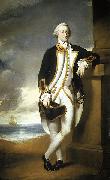 |
George Dance the Younger
|
|
George Dance the Younger (1 April 1741 - 14 January 1825) was an English architect and surveyor. The fifth and youngest son of George Dance the Elder, he came from a distinguished family of architects, artists and dramatists. He was hailed by Sir John Summerson as "among the few really outstanding architects of the century", but few of his buildings remain.
He was educated at the St. Paul's School, London. Aged 17, he was sent to Italy to prepare himself for an architectural career and joined his brother Nathaniel, who was studying painting in Rome. George was a member of academies in Italy, showing much promise as a draughtsman, and much of his later work was inspired by Piranesi, with whom he was acquainted.
He succeeded his father as City of London surveyor and architect on his father's death in 1768, when he was only 27. He had already distinguished himself by designs for Blackfriars Bridge, sent to the 1761 exhibition of the Incorporated Society of Artists.
His earliest London project was the rebuilding of All Hallows-on-the-Wall church in 1767. His first major public works were the rebuilding of Newgate Prison in 1770 and the front of the Guildhall, London. His other London works include the church of St Bartholomew-the-Less (1797). In Bath he largely designed the Theatre Royal, built by John Palmer in 1804-5. Sir John Soane was a pupil.
Many of his buildings have been demolished, including the Royal College of Surgeons, Newgate Prison, St Luke's Hospital for Lunatics, the Shakespeare Gallery in Pall Mall, the library at Lansdowne House, the Common Council Chamber and Chamberlain's Court at the Guildhall, Ashburnham Place, and Stratton Park (demolished save for its Tuscan portico)
With his brother Nathaniel, he was a founder member of the Royal Academy in 1768, and its second professor of architecture, from 1798 to 1805. For a number of years, he was the last survivor of the 40 original Academicians.
|
 |
Gentile da Fabriano
|
|
1370-1427
Italian
Gentile da Fabriano Locations
Gentile da Fabriano, whose real name was Gentile di Niccolo di Giovanni di Massio, came from Fabriano in the Marches. According to tradition, his family was an old one and moderately prosperous. His father, who was said to have been a scholar, mathematician, and astrologer, became an Olivetan monk when a monastery of that order was established in Fabriano in 1397. Gentile brother, Ludovico, was a monk of the same order in Fabriano, and Gentile himself was living in the Olivetan monastery of S. Maria Nuova in Rome at the time of his death. A document of Oct. 14, 1427, speaks of him as dead.
Gentile art indicates that he was probably trained in Lombardy, perhaps in Milan. He worked in the then current International Gothic style, to which he brought his own personal quality. His earliest works display the decorative rhythmic drapery patterns preferred by the International Gothic masters, which Gentile tempered and ultimately abandoned after his contact with Florentine art.
In a document of 1408 Gentile is recorded in Venice, where he painted an altarpiece (now lost) for Francesco Amadi. Testifying to his high reputation was his commission in 1409 for frescoes in the Doges Palace in Venice (painted over in 1479). Pandolfo Malatesta commissioned Gentile to decorate a chapel (destroyed) in Brescia in 1414. The artist is last recorded in Brescia on Sept. 18, 1419, when he departed for Rome to answer the summons of Pope Martin V. Gentile name first appeared on the roll of painters in Florence in 1421. He was in Siena in 1420 and 1424-1425 and in Orvieto late in 1425. From 1426 until the time of his death he was in Rome.
Typical of Gentile early style is the polyptych (ca. 1400) from the convent of Valle Romita in Fabriano, in which Gentile displays the International Gothic love for naturalistic detail in the floral turf beneath the feet of the graceful, slender saints whose figures are swathed in rhythmic, linear drapery. The central panel, the Coronation of the Virgin, shows the love for calligraphic drapery so characteristic of Gentile early style. Other noteworthy early works include the much damaged Madonna in Perugia and the Madonna with Saints and Donor in Berlin.
The altarpiece Adoration of the Magi, signed and dated 1423, was Gentile major work in Florence. In remarkably good condition, with its original frame still intact, it shows Gentile Gothicism now tempered by his contact with the more austere art of Florence. The rich display of gold leaf and brilliant colors were favorite International Gothic traits, but in the interest in perspective and foreshortening and especially in the exquisite predella panels Gentile shows the influence of the Florentines.
The altarpiece for the Quaratesi family, signed and dated 1425, also demonstrates the composite quality of Gentile art. The fresco Madonna Enthroned in Orvieto Cathedral of late 1425 has few traces of the International Gothic style and displays a corporeality and fullness in keeping with his evolution after Florence. His last works, the frescoes in St. John Lateran in Rome depicting the life of John the Baptist and grisaille portraits of saints, were destroyed in 1647, when Francesco Borromini reconstructed the interior. |
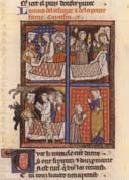 |
Gautier de Coinci
|
|
1177-1236 French,Born of noble stock, Gautier became a Benedictine novice at Saint-M??dard de Soissons in 1193 and prior at Vic-sur-Aisne in 1214, returning to Saint-M??dard to be grand prior (1233) until his death. His single work, preserved in nearly 80 manuscripts, is the massive Miracles de Nostre Dame, written at Vic (1214-27) and occupying some 30, 000 lines in two books. |
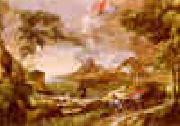 |
Gaspard Dughet
|
|
1615-1675
French Gaspard Dughet Location
Italian painter. He was one of the most distinguished landscape painters working in Rome in the 17th century, painting decorative frescoes and many easel paintings for such major Roman patrons as Pope Innocent X and the Colonna family. He is associated with a new genre of landscape, the storm scene, although of some 400 catalogued works little more than 30 treat this theme. His most characteristic works depict the beauty of the scenery around Rome, particularly near Tivoli, and suggest the shifting patterns of light and shade across a rugged terrain. Dughet drew from nature, yet his landscapes are carefully structured, and figures in antique dress suggest the ancient beauty of a landscape celebrated by Virgil. Very few can be securely dated; his development may be inferred from his few dated fresco paintings and from the wider context in which he was working. Most writers, following Pascoli, have divided Dughet career into three periods. His first landscapes were a little dry (Pascoli); in his second period he developed a more learned style, closer to that of his teacher, Nicolas Poussin; his late works were more intimate and more original.
|
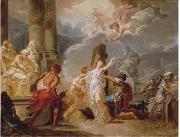 |
Gabriel-Francois Doyen
|
|
(1726 - 5 June 1806) was a French painter, who was born at Paris.
His passion for art prevailed over his father's wish, and he became in his twelfth year a pupil of Charles-Andra van Loo. Making rapid progress, he obtained at twenty the Grand Prix, and in 1748 set out for Rome. He studied the works of Annibale Carracci, Pietro Berrettini da Cortona, Giulio Romano and Michelangelo, then visited Naples, Venice, Bologna and other Italian cities, and in 1755 returned to Paris. At first unappreciated and disparaged, he resolved by one grand effort to achieve a reputation, and in 1758 he exhibited his Death of Virginia. It was completely successful, and procured him admission to the Acad??mie Royale de Peinture et de Sculpture. Among his greatest works are reckoned the Miracle des Ardents, painted for the church of St Genevieve at St Roch (1767)this painting was exhibited in the salon of 1767 which was recorded by Saint-Aubin in "View of the salon of 1767"; the Triumph of Thetis, for the chapel of the Invalides; and the Death of St Louis, for the chapel of the Military School. In 1776 he was appointed professor at the Academy. Soon after the beginning of the French Revolution he accepted the invitation of Catherine II of Russia. and settled at St Petersburg, where he was loaded with honors and rewards. He died there on 5 June 1806.
|
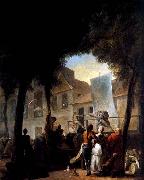 |
Gabriel Jacques de Saint-Aubin
|
|
French Painter, 1724-1780,Draughtsman, etcher and painter, brother of (1) Charles-Germain de Saint-Aubin. He studied with the painters Etienne Jeaurat and Hyacinthe Colin de Vermont, but failed three times to win the Prix de Rome (competition paintings, 1752-4; Paris, Louvre). He broke with the Academie Royale, preferring to support and exhibit at the Academie de St Luc. Although he continued to paint such pictures as a Street Show in Paris (c. 1760; London, N.G.; other examples in Rouen, Mus. B.-A.), he is best known as a draughtsman and etcher. He was a passionate and unconventional observer of the sights of the Paris streets and of the social scene. Dacier saw him as the 'man who drew at all times and in all places', and his contemporary Jean-Baptiste Greuze spoke of his 'priapism of draughtsmanship'. In his many drawings he combined pencil, black and red chalk, bistre, ink and watercolour to create dazzling spontaneous effects. He drew incidents that struck him as he wandered the streets, or entertainments that he attended. He recorded them, noting dates and times, in sketchbooks (e.g. Paris, Louvre and Stockholm, Nmus.) or sometimes in the margins and blank pages of printed books that he was carrying (such as a volume of the poems of Jean-Michel Sedaine, in the Mus. Cond?, Chantilly). These drawings of contemporary incidents include the Fire at the Foire Saint-Germain on the Night of 16-17 May 1762 (ex-David Weill priv. col.) and the Crowning of Voltaire at the Theetre-Franeais in 1778 (Paris, Louvre; see fig.). He went regularly to the Salon of the Academie Royale and to art sales, covering the margins and flyleaves of his sale catalogues and Salon livrets with tiny sketches of works of art and the passing scene. One hundred of these illustrated catalogues were among his effects when he died, and of these about a third survive. These include the livrets for the Salons of 1761, 1769 and 1777 (all Paris, Bib. N.), as well as the catalogues of the sales of Louis-Michel van Loo in 1772 and Charles Natoire in 1778 (both Paris, Bib. N.), and that of Pierre-Jean Mariette in 1775 (Boston, MA, Mus. F.A.). Together with his etchings and large watercolours (e.g. Paris, Louvre) of the Louvre's Salon Carre at the time of the exhibitions of 1753, 1767 and 1769, |
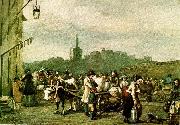 |
fritz von dardel
|
|
Fritz Ludvig von Dardel, född den 24 mars 1817 i Neuchâtel, död den 27 maj 1901 i Stockholm, var en schweiziskfödd svensk överintendent, militär, målare och tecknare.
Fritz von Dardel var son till godsägaren Georges-Alexandre von Dardel och grevinnan Hedvig Sofia Charlotta Amalia Lewenhaupt. Han var gift med friherrinnan Augusta Silfverschiöld. Släkten von Dardel kommer från Schweiz och adlades i Sverige 1810.
Von Dardel blev vid sexton års ålder konstapelkadett vid Vendes artilleriregemente, 1837 underlöjtnant vid Svea livgarde och avancerade till överstelöjtnant i armen 1862. Han blev 1850 adjutant hos kronprinsen och sedan hos Karl XV. Von Dardel var 1858-62 militärattach?? i Paris samt blev 1864 kabinettskammarherre hos Karl XV och samma år överintendent och ordföranden i Akademin för de fria konsterna, av vilken han 1861 invalts till hedersledamot. Dessutom var han ordförande i Nationalmuseums nämnd i 25 år (1867-92).
Vid flera konstutställningar i Europa (1867, 1871, 1873 och 1878) samt i Philadelphia (1876) var han juryman.
Själv hade von Dardel bedrivit studier på L??on Cogniets och E. Lamis ateljeer i Paris.
Fritz von Dardel tillhörde Karl XV:s intima krets och har gjort ett flertal dråpliga, akvarellerade teckningar av personer och händelser vid hovet eller under kungens resor, vidare folklivsbilder samt litografier. Hans dagböcker (se nedan) som utgavs postumt är skrivna på franska och översatta och redigerade av hans söner. |
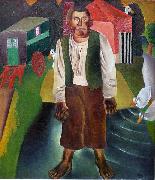 |
Frits Van den Berghe
|
|
(3 April 1883 - 22 September 1939) was a Belgian expressionist painter.
He was born at Ghent. Like his friends Constant Permeke and Gustave De Smet, he first adopted the late-impressionist style of Emile Claus, but converted to expressionism during World War I.
|
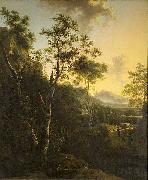 |
Frederik de Moucheron
|
|
(1633-2 January 1686) was a Dutch Golden Age landscape painter.
Frederik de Moucheron was the son of the painter Balthazar de Moucheron and Cornelia van Brouckhoven. His father came from a wealthy family of wine traders and is portrayed as one of the younger sons in the Moucheron Family portrait, 1563. Frederik trained with Jan Asselijn and became a landscape painter. He set off at age 22 for Paris, where he spent 3 years and then after a tour of Antwerp, Paris. and Lyon, he settled in 1659 in Amsterdam. In the same year he married Mariecke de Jouderville there and they had 11 children. He is buried in Amsterdam.
He painted French, Italian, and Dutch landscapes. To finish these scenes, contemporaries specialized in painting figures collaborated with him, such as Adriaen van de Velde in Amsterdam, Theodor Helmbreker in Paris, and at times Johannes Lingelbach, and Nicolaes Pieterszoon Berchem.
|
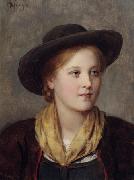 |
Franz von Defregger
|
|
(after 1883 Franz von Defregger) (30 April 1835 - 2 January 1921) was an Austrian artist known mostly for his genre and history paintings.
He was born in Ederhof at Stronach, in Tyrol, the son of a prosperous farmer. In 1860, following his father's death, Franz sold the family's farm and went to Innsbruck, where he studied with the sculptor Michael Stolz. He went to Munich in 1861 to study under Hermann Dyck and Hermann Anschetz. In 1863 he travelled to Paris, where he continued his artistic education autodidactically by a routine of figure drawing and a thorough study of the museums, art collections and studios. On 8 July 1865 he returned to Munich, where from 1867 to 1870 he studied alongside Hans Makart and Gabriel Max in the studio of history painter Karl von Piloty.
Defregger became one of the leading genre painters in Munich, and became a professor of history painting at the Munich Academy, where he continued to teach until 1910. He died in Munich in 1921. |
 |
Franz Dvorak
|
|
Franz Dvorak (1862-1927)
The Hungarian painter, F. Dvorak, has won a reputation by pictures of the decorative order, of which "Spring" is an excellent example. As is common with painters of his nationality, he is a particularly fine colorist.
|
 |
Frans de Momper
|
|
Flemish Baroque Era Painter, 1603-1660
Painter and draughtsman, nephew of (1) Josse de Momper II. In 1629 he became a master in the Antwerp Guild of St Luke. He left Antwerp for the northern Netherlands, working initially at The Hague; by 1647 he was in Haarlem and the following year Amsterdam, where he married in 1649. In 1650 Frans returned to Antwerp, where he painted numerous monochrome landscapes in the manner of Jan van Goyen. Paintings such as the Valley with Mountains (c. 1640-50; Philadelphia, PA, Mus. A.) prefigure the imaginative landscapes of Hercules Segers. The impression of vast panoramic spaces in Frans's work is adopted from his uncle's art. Frans executed a number of variations on the theme of a river landscape with boats and village (e.g. pen-and-ink drawing, Edinburgh, N.G.). In the late painting Landscape with a Ch?teau Encircled by Doves (Bordeaux, Mus. B.-A.), the low horizon and light-filled sky are adopted from the new Dutch school of tonal landscape painting, while the delicacy of the figures, feathery trees and buildings are features of the Italo-Flemish tradition exemplified by his uncle. Similar qualities of refinement and luminosity characterize the Winter Landscape (c. 1650; Prague, N.G., Sternberk Pal.), |
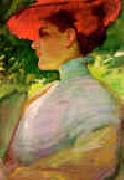 |
Frank Duveneck
|
|
1848-1919
Frank Duveneck Gallery
Frank Duveneck (October 9, 1848 ?C January 3, 1919) was an American figure and portrait painter.
Duveneck was born in Covington, Kentucky, the son of a German immigrant Bernard Decker. Decker died when Frank was only a year old and his widow remarried Joseph Duveneck. By the age of fifteen Frank had begun the study of art under the tutelage of a local painter, Johann Schmitt and had been apprenticed to a German firm of church decorators. While having grown up in Covington, Duveneck was a part of the German community in Cincinnati, Ohio. However, due to his Catholic beliefs and German heritage, he was an outsider as far as the artistic community of Cincinnati was concerned. In 1869 he went abroad to study with Wilhelm von Diez and Wilhelm Leibl at the Royal Academy of M??nich, where he learned a dark, realistic and direct style of painting. He subsequently became one of the young American painters ?? others were William Merritt Chase, John Henry Twachtman, and Walter Shirlaw ?? who in the 1870s overturned the traditions of the Hudson River School and started a new art movement characterized by a greater freedom of paint application. |
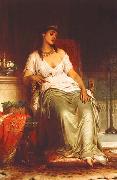 |
Frank Bernard Dicksee
|
|
(b. London, 27 November 1853 - 17 October 1928) was an English Victorian painter and illustrator, best known for his pictures of dramatic historical and legendary scenes. He also was a noted painter of portraits of fashionable women, which helped to bring him success in his own time.
Dicksee's father, Thomas Dicksee, was a painter who taught Frank as well as his brother Herbert and his sister Margaret from a young age. Dicksee enrolled in the Royal Academy in 1870 and achieved early success. He was elected to the Academy in 1891 and became its President in 1924. He was knighted in 1925, and named to the Royal Victorian Order by King George V in 1927.
Dicksee painted the piece 'The Funeral of a Viking' in 1893, which now resides in Manchester City Art Gallery, having been there since 1928 when it was presented by Arthur Burton ESQ in memory of his mother to the Corporation of Manchester. Victorian critics gave it both positive and negative reviews, for its perfection as a showpiece and for its dramatic and somewhat staged setting, respectively. The painting was used by Swedish Viking/Black metal band Bathory for the cover of their 1990 album, Hammerheart.
|
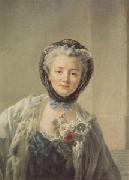 |
Francois-Hubert Drouais
|
|
Paris 1727-Rome 1775
was a French painter and Jean-Germain Drouais's father. He specialized in portraits, some of which include Louis XV's last two mistresses, Madame de Pompadour and Madame du Barry respectively. He even painted the young Marie Antoinette. |
|
|
Francois Dumont
|
|
(1751-1831) was a French painter of portrait miniatures
Dumont was born at Lunville (Meurthe), and was left an orphan when quite young, with five brothers and sisters to support. He was for a while a student under Jean Girardet, and then, on. the advice of a Lunville Academician, Madame Coster, set up a studio for himself. In 1784 he journeyed to Rome, returning after four years careful study, and in 1788 was accepted as an Academician and granted an apartment in the Louvre. He married the daughter of Antoine Vestier, the miniature painter, and had two sons, Aristide and Bias, both of whom became painters.
Dumont was one of the three greatest miniature painters of France, painting portraits of Louis XVI, Marie Antoinette, Louis XVIII and Charles X, and of almost all the important persons of his day. His own portrait was engraved both by Francis Audouin and by Jean-Charles Tardieu.
He resided the greater part of his life in Paris, and there he died. A younger brother, Tony Dumont, was also a miniature painter, a pupil of his brother, a frequent exhibitor and the recipient of a medal from the Academy in 1810. Each artist signed with the surname only, and there is some controversy concerning the attribution to each artist of his own work. Tony was an expert violinist and delighted in painting portraits of persons who were playing upon the violin.
Many of Dumont's finest paintings came into the collection of J. P. Morgan, but others are in the Louvre, presented by the heir of Bias Dumont. The work of both painters is distinguished by breadth, precision and a charming scheme of coloring, and the unfinished works of the elder brother are amongst some of the most beautiful miniatures ever produced.
|
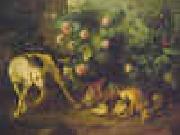 |
Francois Desportes
|
|
1661-1743
Francois Desportes Locations
French painter. He is best known for his hunting scenes and paintings of animals. Desportes, who began as a portrait painter, was among the first to paint landscapes from nature; for that practice he was held to be eccentric. His works are in the tradition of careful realism of Flemish still-life paintings. The Louvre and the Wallace Collection, London, have examples of his work. |
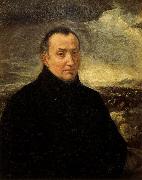 |
Francois de Troy
|
|
French Baroque Era Painter, 1645-1730
was a French painter and engraver who became principal painter to King James II in exile at Saint-Germain-en-Laye and Director of the Academie Royale de peinture et de sculpture. One of a family of artists, Troy was born in Toulouse, the son of Nicolas de Troy (1608 - 15 September 1684), a painter in that city,and was the brother of Jean de Troy (4 April 1638 - 25 June 1691).Troy was taught the basic skills of painting by his father, and perhaps also by the more worldly Antoine Durand. François de Troy is not to be confused with his son, the portrait painter Jean-François de Troy (1679-1752), who studied under him At some time after 1662, Troy went to Paris to study portrait painting under Claude Lefebvre (1633-1675) and Nicolas-Pierre Loir (1624 - C1679]. A. P. F. Robert-Dumesnil states that this occurred when Troy was aged twenty-four. In 1669, Troy married his master Nicolas-Pierre Loir's sister-in-law, Jeanne Cotelle. In 1671, he was approved by the Academie Royale de peinture et de sculpture. In 1674, he was received into the Academy as a history painter, with a reception piece (morceau de reception) entitled Mercure coupant la tete d'Argus ('Mercury cutting off the head of Argus'). Troy's early known works include tapestry designs for Madame de Montespan, one of the many mistresses of Louis XIV of France, and paintings with religious and mythological subjects. In the 1670s, he became friendly with Roger de Piles, who introduced him to Dutch and Flemish painting, |
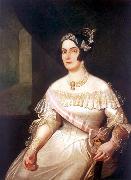 |
Francisco Pedro do Amaral
|
|
Amaral, Francisco Pedro do (1790 - 1831)
painted Portrait of Domitila de Castro Canto e Melo, Marquise of Santos in 19th century
|
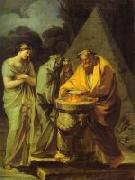 |
Francisco Jose de Goya
|
|
Spanish Rococo Era/Romantic Painter and Printmaker, 1746-1828
Goya is considered the 18th Century's foremost painter and etcher of Spanish culture, known for his realistic scenes of battles, bullfights and human corruption. Goya lived during a time of upheaval in Spain that included war with France, the Inquisition, the rule of Napoleon's brother, Joseph, as the King of Spain and, finally, the reign of the Spanish King Ferdinand VII. Experts proclaim these events -- and Goya's deafness as a result of an illness in 1793 -- as central to understanding Goya's work, which frequently depicts human misery in a satiric and sometimes nightmarish fashion. From the 1770s he was a royal court painter for Charles III and Charles IV, and when Bonaparte took the throne in 1809, Goya swore fealty to the new king. When the crown was restored to Spain's Ferdinand VII (1814), Goya, in spite of his earlier allegiance to the French king, was reinstated as royal painter. After 1824 he lived in self-imposed exile in Bordeaux until his death, reportedly because of political differences with Ferdinand. Over his long career he created hundreds of paintings, etchings, and lithographs, among them Maya Clothed and Maya Nude (1798-1800); Caprichos (1799-82); The Second of May 1808 and The Third of May 1808 (1814); Disasters of War (1810-20); and The Black Paintings (1820-23). |
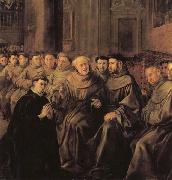 |
Francisco de herrera the elder
|
|
Spanish Baroque Era Painter, ca.1590-1656
Spanish painter. His early works are in the Mannerist style. Under the influence of Francisco Zurbaren, he developed the naturalistic style seen in his four scenes from the life of St. Bonaventure (1627). About 1650 he moved to Madrid. His last documented work, a painting of St. Joseph (1648) influenced by Anthony Van Dyck, features elongated forms and elaborate draperies. He achieved considerable fame in Sevilla, where Diego Velezquez was briefly his pupil. His work marked the transition from Mannerism to the Baroque. His son, Francisco Herrera the Younger |
 |
Francisco de goya y Lucientes
|
|
b. March 30, 1746, Fuendetodos, Spain--d. April 16, 1828,
Goya is considered the 18th Century's foremost painter and etcher of Spanish culture, known for his realistic scenes of battles, bullfights and human corruption. Goya lived during a time of upheaval in Spain that included war with France, the Inquisition, the rule of Napoleon's brother, Joseph, as the King of Spain and, finally, the reign of the Spanish King Ferdinand VII. Experts proclaim these events -- and Goya's deafness as a result of an illness in 1793 -- as central to understanding Goya's work, which frequently depicts human misery in a satiric and sometimes nightmarish fashion. From the 1770s he was a royal court painter for Charles III and Charles IV, and when Bonaparte took the throne in 1809, Goya swore fealty to the new king. When the crown was restored to Spain's Ferdinand VII (1814), Goya, in spite of his earlier allegiance to the French king, was reinstated as royal painter. After 1824 he lived in self-imposed exile in Bordeaux until his death, reportedly because of political differences with Ferdinand. Over his long career he created hundreds of paintings, etchings, and lithographs, among them Maya Clothed and Maya Nude (1798-1800); Caprichos (1799-82); The Second of May 1808 and The Third of May 1808 (1814); Disasters of War (1810-20); and The Black Paintings (1820-23). |
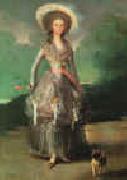 |
Francisco de Goya
|
|
Spanish
1746-1828
Francisco de Goya Locations
was an Aragonese Spanish painter and printmaker. Goya was a court painter to the Spanish Crown and a chronicler of history. He has been regarded both as the last of the Old Masters and as the first of the moderns. The subversive and subjective element in his art, as well as his bold handling of paint, provided a model for the work of later generations of artists, notably Manet and Picasso.
Goya married Bayeu's sister Josefa in July 25, 1773. His marriage to Josefa (he nicknamed her "Pepa"), and Francisco Bayeu's membership of the Royal Academy of Fine Art (from the year 1765) helped him to procure work with the Royal Tapestry Workshop. There, over the course of five years, he designed some 42 patterns, many of which were used to decorate (and insulate) the bare stone walls of El Escorial and the Palacio Real de El Pardo, the newly built residences of the Spanish monarchs. This brought his artistic talents to the attention of the Spanish monarchs who later would give him access to the royal court. He also painted a canvas for the altar of the Church of San Francisco El Grande, which led to his appointment as a member of the Royal Academy of Fine Art.
In 1783, the Count of Floridablanca, a favorite of King Carlos III, commissioned him to paint his portrait. He also became friends with Crown Prince Don Luis, and lived in his house. His circle of patrons grew to include the Duke and Duchess of Osuna, whom he painted, the King and other notable people of the kingdom.
After the death of Charles III in 1788 and revolution in France in 1789, during the reign of Charles IV, Goya reached his peak of popularity with royalty. |
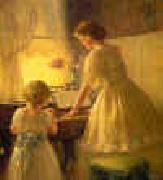 |
Francis Day
|
|
Francis Day CIE (1829-1889) was Inspector-General of Fisheries in India(from circa 1871) and Burma and an ichthyologist.
He was born on the 2nd of March 1829 Maresfield, Sussex, UK third son of William and Ann Day. He became the medical officer in the Madras Presidency, East India Company services in 1852.
Francis Day was created a Companion of the Order of the Indian Empire in 1885. He was decorated with the 0rder of the crown of Italy. He retired in 1877.
He wrote a monograph on fishes between 1875-1878 "The Fishes of India" with a supplement in 1888 and two volumes on "Fishes" in the Fauna of British India series in which he described over 1400 species. Also wrote British and Irish Salmonadae, which he illustrated with 9 plates, the colouring of which was done by Miss Florence Woolward. Francis Day was granted an honary LLD by the University of Edinburgh.
Also Published Fishes of Malabar in 1865
Franics Day was an active member, and president of the Cheltenham Natural Sciences Society and presented papers to them. Also was an active member of the Cotswold Field Club, where he was vice president. He died at his residence, Kenilworth House, Cheltenham on the 10th of July 1889 of cancer of the stomach. Buried in Cheltenham cemetery. |
 |
Francis Davis Millet
|
|
(November 3, 1846 - April 15, 1912) was an American painter, sculptor, and writer who died in the sinking of the RMS Titanic on April 15, 1912.
Francis Davis Millet was born in Mattapoisett, Massachusetts. At age sixteen, Millet entered the Massachusetts regiment, first as a drummer boy and then a surgical assistant in the American Civil War. He repeatedly pointed to his experience working for his father as giving him an appreciation for the vivid blood red that he repeatedly used in his early paintings. |
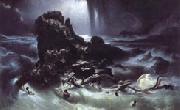 |
Francis Danby
|
|
Irish Painter, 1793-1861
was a British painter of the Romantic eraBorn in the south of Ireland, he was one of a set of twins; his father, James Danby, farmed a small property he owned near Wexford, but his death, in 1807, caused the family to move to Dublin, while Francis was still a schoolboy. He began to practice drawing at the Royal Dublin Society's schools; and under an erratic young artist named James Arthur O'Connor he began painting landscapes. Danby also made acquaintance with George Petrie, and all three left for London together in 1824. This expedition, undertaken with very inadequate funds, quickly came to an end, and they had to get home again by walking. At Bristol they made a pause, and Danby, finding he could get trifling sums for water-color drawings, remained there working diligently and sending to the London exhibitions pictures of importance. There his large oil paintings quickly attracted attention. Danby painted "vast illusionist canvases" comparable to those of John Martin of "grand, gloomy and fantastic subjects which chimed exactly with the Byronic taste of the 1820s."The Upas Tree (1820) and The Delivery of the Israelites (1825) brought him his election as an Associate Member of the Royal Academy. He left Bristol for London, and in 1828 exhibited his Opening of the Sixth Seal at the British Institution, receiving from that body a prize of 200 guineas; and this picture was followed by two others on the theme of the Apocalypse. In 1829 Danby's wife deserted him, running off with the painter Paul Falconer Poole Danby left London, declaring that he would never live there again, and that the Academy, instead of aiding him, had, somehow or other, used him badly. For a decade he lived on the Lake of Geneva in Switzerland, becoming a Bohemian with boat-building fancies, painting only now and then. He later moved to Paris for a short period of time. He returned to England in 1840, when his sons, James and Thomas, both artists, were growing up. Danby exhibited his large (15 feet wide) and powerful The Deluge that year; the success of that painting, "the largest and most dramatic of all his Martinesque visions, revitalized his reputation and career. Other pictures by him were The Golden Age (c. 1827, exhibited 1831), Rich and Rare Were the Gems She Wore (1837), and The Evening Gun (1848). Some of Danby's later paintings, like The Woodnymph's Hymn to the Rising Sun (1845), tended toward a calmer, more restrained, more cheerful manner than those in his earlier style; but he returned to his early mode for The Shipwreck (1859). |
 |
Francesco di Giorgio Martini
|
|
Italian Early Renaissance Painter and Sculptor, 1439-ca.1501
was an Italian painter of the Sienese School, a sculptor, an architect and theorist, and a military engineer who built almost seventy fortifications for the Duke of Urbino. Born in Siena, he apprenticed as a painter with Vecchietta. In panels painted for cassoni he departed from the traditional representations of joyful wedding processions in frieze-like formulas to express visions of ideal, symmetrical, vast and all but empty urban spaces rendered in perspective. Francesco di Giorgio is also known for architectural designs and sculptural work for Federico III da Montefeltro, Duke of Urbino, for whom he built star-shaped fortifications. He composed an architectural treatise Trattato di architettura, ingegneria e arte militare that he worked on for decades and finished sometime after 1482; |
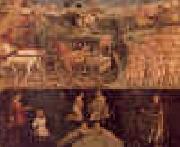 |
Francesco del Cossa
|
|
Italian
c1435-c1478
Francesco del Cossa Location
Italian painter. He was a leading representative of the Ferrarese school and was regarded, with Ercole de Roberti, as the founder of the Bolognese school. His principal works include The Glorification of March, April, and May, frescoes in the Schifanoia Palace, Ferrara; some admirable portraits of the artist contemporaries; Madonna Enthroned (Bologna); Madonna and Child with Angels, St. Liberal, and St. Lucy (National Gall. of Art, Washington, D.C.); and an altarpiece representing scenes from the life of St. Vincent Ferrer (National Gall., London, and the Vatican). |
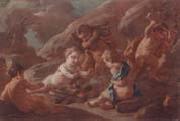 |
Francesco de mura
|
|
Italian Painter , b. 1696, Napoli, d. 1782, Napoli
was an Italian painter of the late-Baroque period, active mainly in Naples and Turin. His late work reflects the style of neoclassicism. He was a pupil of Francesco Solimena, then later with Domenico Viola, where he met his contemporary, Mattia Preti. While still in his teens he painted frescoes (1715) in San Nicola alla Carit?? in Naples. He painted ten canvases of the Virtues and an Adoration of the Magi (1728) for the church of Santa Maria Donnaromita. His other works include frescoes of the Adoration of the Magi (1732) in the apsidal dome of the church of the Nunziatella. |
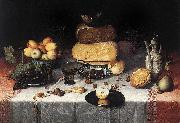 |
Floris van Dyck
|
|
, also called Floris van Dijck or Floris Claesz. van Dyck (Delft or Haarlem, c. 1575 - Haarlem, before 26 April 1651), was a Dutch Golden Age still life painter.
He lived in Haarlem for most of his life, but he was born in Delft. He was a cousin of Pieter Cornelisz van Dijck. In 1600 he is documented as being in Rome, indicating he made a journey to Italy. In 1606 he returned to the Netherlands, where he joined the Haarlem Guild of St. Luke in 1610 and became dean in 1637. He was influenced by Osias Beert and Clara Peeters. He is considered the inventor of the banketje (banquet still life genre similar to breakfasts, or ontbijtjes), together with Nicolaes Gillis. |
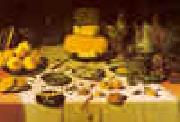 |
Floris van Dijck
|
|
Dutch Baroque Era Painter, 1575-1651
Dutch painter and draughtsman. He is thought to have been a pupil of Rembrandt in Amsterdam c. 1650. There is no documentary evidence for this, but his earliest dated painting, the Presentation in the Temple shows that he had certainly seen examples of Rembrandt work. He was an eclectic artist, given to following several models simultaneously. This is evident from two versions of Elijah and the Widow of Zarephath; one (1655-60; Copenhagen, Stat. Mus. Kst) is painted in horizontal format in the style of Barent Fabritius, while the other (1655-60; Milwaukee, WI, A. Bader priv. col., see Sumowski, 1983, no. 362) features large half-length figures in the manner of Nicolaes Maes. In another biblical scene, Benjamin and Judah (1655-60; Chicago, IL, A. Inst.), he followed the example of Rembrandt. His best works, such as Saying Grace (1655-60; Hannover, Nieders?chs. Landesmus.) and the Old Prophetess (1655-60; Leipzig, Mus. Bild. Kst), show old women either praying or sleeping and confirm that Maes was his main source of inspiration. Similar subjects are represented in the drawings attributed to him (e.g. Old Woman Seated, Holding a Book; New York, Pierpont Morgan Lib.). In the late 1650s van Dijck also seems to have been influenced by the genre paintings of Gabriel Metsu and above all by Quiringh van Brekelenkam, as in Hermit Praying in a Cave (late 1650s; St Petersburg, Hermitage) and Family Saying Grace (late 1650s; Stockholm, Nmus.). |
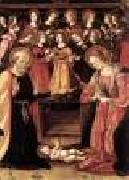 |
FIORENZO DI LORENZO
|
|
Italian painter, Umbrian school (b. ca. 1445, Perugia, d. ca. 1525, Perugia) |
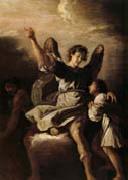 |
Fetti,Domenico
|
|
Italian painter , 1589-1623
was an Italian Baroque painter active mainly in Rome, Mantua and Venice. Born in Rome to a little-known painter, Pietro Fetti, Domenico is said to have apprenticed initially under Ludovico Cigoli, or his pupil Andrea Commodi in Rome from circa 1604-1613. He then worked in Mantua from 1613 to 1622, patronized by the Cardinal, later Duke Ferdinando I Gonzaga. In the Ducal Palace, he painted the Miracle of the Loaves and Fishes. The series of representations of New Testament parables he carried out for his patron's studiolo gave rise to a popular specialty, and he and his studio often repeated his compositions. In August or September 1622, his feuds with some prominent Mantuans led him to move to Venice, which for the first few decades of the seventeenth century had persisted in sponsoring Mannerist styles (epitomized by Palma the Younger and the successors of Tintoretto and Veronese). Into this mix, in the 1620s-C30s, three "foreigners" Fetti and his younger contemporaries Bernardo Strozzi and Jan Lysebreathed the first influences of Roman Baroque style. |
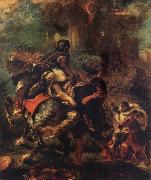 |
Ferdinand Victor Eugene Delacroix
|
|
Charenton Saint Maurice 1798-Paris 1863,was a French Romantic artist regarded from the outset of his career as the leader of the French Romantic school. Delacroix's use of expressive brushstrokes and his study of the optical effects of colour profoundly shaped the work of the Impressionists, while his passion for the exotic inspired the artists of the Symbolist movement. A fine lithographer, Delacroix illustrated various works of William Shakespeare, the Scottish writer Sir Walter Scott, and the German writer Johann Wolfgang von Goethe. In contrast to the Neoclassical perfectionism of his chief rival Ingres, Delacroix took for his inspiration the art of Rubens and painters of the Venetian Renaissance, with an attendant emphasis on color and movement rather than clarity of outline and carefully modeled form. Dramatic and romantic content characterized the central themes of his maturity, and led him not to the classical models of Greek and Roman art, but to travel in North Africa, in search of the exotic.Friend and spiritual heir to Theodore Gericault, |
 |
Felix Maria Diogg
|
|
(b Andermatt, 1 July 1762; d Rapperswil, Schwyz, 19 Feb 1834). Swiss painter. From 1782 he was a pupil of Johann Melchior Wyrsch in Besanion, under whom he developed the essential aspects of his portrait style. He also studied further in Rome and Naples from 1786 to 1788. He was capable of executing bright, incisive portraits in the manner of Angelica Kauffman, as in Portrait of an Artist or psychological studies, best seen in Ulysses von Salis-Marschlins. Several of his group portraits, such as the Esslinger Family, show the influence of Italian and British painting, with which he seemed to be familiar. He was a friend of Johann Kaspar Lavater, discoursed with Goethe and enjoyed the company of the Swiss historian Johannes von Miller (1752-1809), whose portrait he painted. His portraits are generally bust-length types set against a solid, dark background. This format was favoured by his Swiss clientele and is seen in Burgomaster Heinrich Krauer (1799; Lucerne, Kstmus.), which also reveals the dignified wooden pose frequently selected by his models. His direct, fashionable treatment of the sitter attracted a wide range of clients from all levels of society. He seemed to be as much at ease painting the Empress of Russia, Yelisaveta Alekseyevna (1814; Karlsruhe, Staatl. Ksthalle) as he was portraying the bourgeoisie of central Switzerland. |
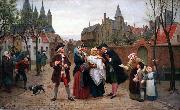 |
Felix de Vigne
|
|
(16 March 1806 - 5 December 1862) was a Belgian painter.
De Vinge was a history painter, engraver, art historian, and instructor at the Royal Academy of Fine Arts (Ghent). In 1847 he published Recherches historiques sur les costumes civils et militaires, an illustrated compendium of the flags, shields and costumes of medieval guilds and military groups.
He was the brother of sculptor Pieter De Vigne (1812-1877), father of Brussels architect Edmond De Vinge (1841-1918), and the stepfather of painter Jules Breton.
|
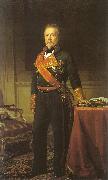 |
Federico de Madrazo y Kuntz
|
|
1815-1894
Spanish
Federico de Madrazo y Kuntz Gallery
Born in Rome, he was the son of the painter Madrazo y Agudo (1781-1859), and received his first instruction from his father. While still attending the classes at the Royal Academy of San Fernando, he painted his first picture, The Resurrection of Christ (1829), which was purchased by Queen Christina. Not long afterwards he painted Achilles in his Tent, and subsequently presented to the Academy The Continence of Scipio, which secured him admission as a member "for merit".
While decorating the palace of Vista Alegre he took up portraiture. In 1852 he went to Paris, where he studied under Franz Winterhalter, and painted portraits of Baron Taylor and Ingres. In 1837 he was commissioned to produce a picture for the gallery at Versailles, and painted "Godfrey de Bouillon proclaimed King of Jerusalem". The artist then went to Rome, where he worked at various subjects, sacred and profane. Then he painted Maria Christina in the Dress of a Nun by the Bedside of Ferdinand III (1843), Queen Isabella, The Duchess of Medina-Coeli, and The Countess de Vilches (1845-1847), besides a number of portraits of the Spanish aristocracy, some of which were sent to the exhibition of 1855.
He received the Legion of Honour in 1846. He was made a corresponding member of the Paris Academy of Fine Arts on 10 December 1853, and in 1873, on the death of Schnorr, the painter, he was chosen foreign member. After his father's death he succeeded him as director of the Museo del Prado and president of the Academy of San Fernando. He originated in Spain the production of art reviews and journals, such as El Artiste, El Renacimiento, and El Semanario pintoresco. He died at Madrid in 1894.
|
 |
Evelyn De Morgan
|
|
1855-1919
British
Evelyn De Morgan Galleries
She was born Evelyn Pickering. Her parents were of upper middle class. Her father was Percival Pickering QC, the Recorder of Pontefract. Her mother was Anna Maria Wilhelmina Spencer Stanhope, the sister of the artist John Roddam Spencer Stanhope and a descendant of Coke of Norfolk who was an Earl of Leicester.
Evelyn was homeschooled and started drawing lessons when she was 15. On the morning of her seventeenth birthday, Evelyn recorded in her diary, "Art is eternal, but life is short..." "I will make up for it now, I have not a moment to lose." She went on to persuade her parents to let her go to art school. At first they discouraged it, but in 1873 she was enrolled at the Slade School of Art. Her uncle, John Roddam Spencer Stanhope, was a great influence to her works. Evelyn often visited him in Florence where he lived. This also enabled her to study the great artists of the Renaissance; she was particularly fond of the works of Botticelli. This influenced her to move away from the classical subjects favoured by the Slade school and to make her own style.
In 1887, she married the ceramicist William De Morgan. They lived together in London until he died in 1917. She died two years later on 2 May 1919 in London and was buried in Brookwood Cemetery, near Woking, Surrey.
|
|

